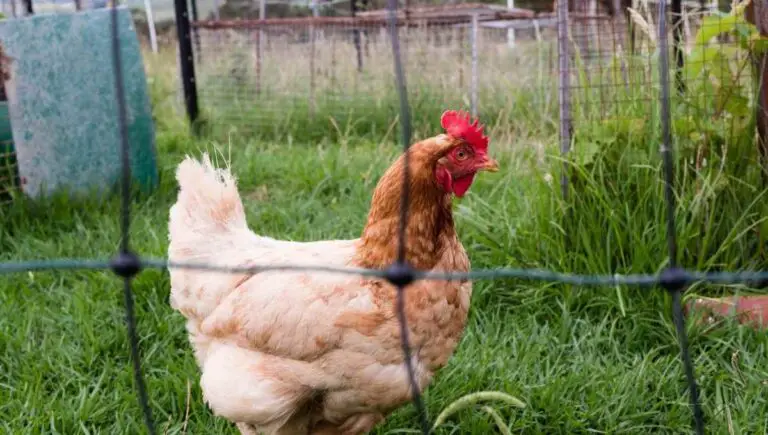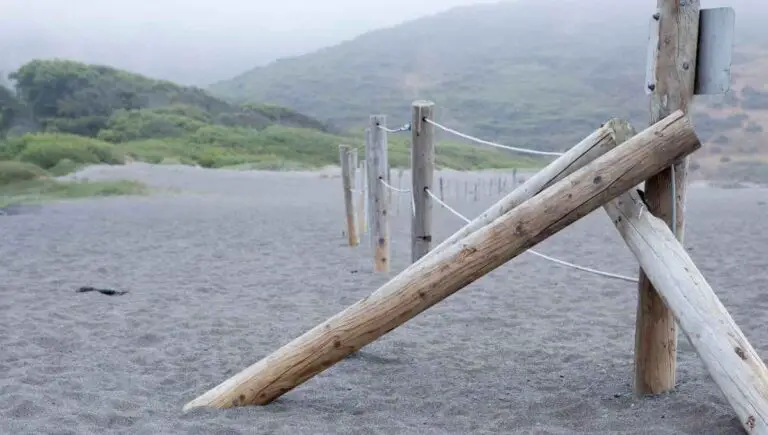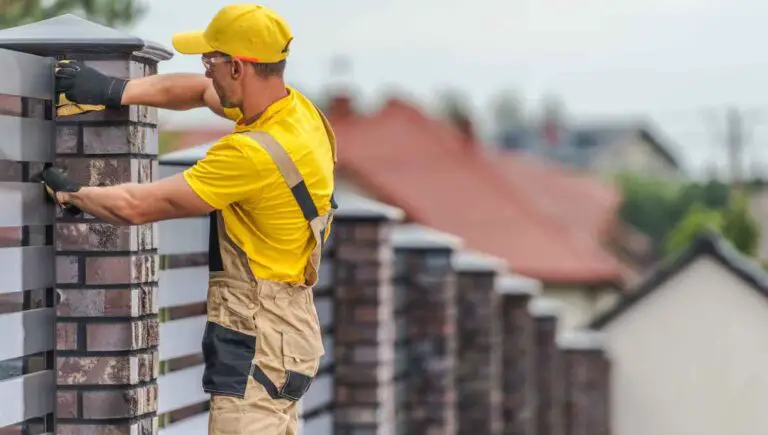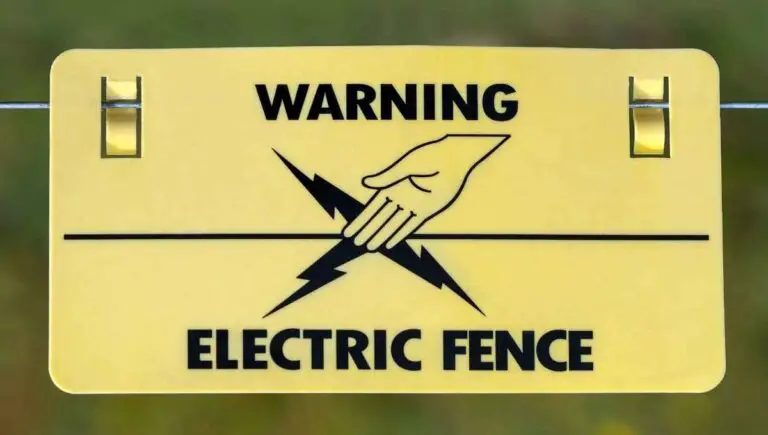Do Fence Posts Need Concrete? (Setting Your Fence Correctly)

Mixing and pouring concrete for fence posts can be quite a hassle, and if you are dealing with a multitude of fence posts, adding concrete can be expensive. If you’ve ever been through this hassle or run the cost of concrete, you probably wondered – do fence posts need concrete?
Fence posts do not need concrete to anchor the fence. Concrete can be used and is suitable for anchoring a fence, but there are many alternatives to concrete to create a sturdy fence. One of the best alternatives is substituting with gravel.
Gravel has additional benefits that make it stand out from concrete. However, there are specific steps you need to take when holding a fence post down with gravel. In this article, we will go over the best ways to anchor fence posts and other concrete alternatives.
This post contains affiliate links from Amazon and other stores. This means Yard Blogger may earn a commission if you make a purchase using any of our links. Please refer to our full affiliate disclosure policy for full details.
Here’s a Quick Pro Tip!
Concrete works for putting in fence posts, but there are other great products to skip the need for concrete. For example, some fence posts do not require additional support after being hammered into the ground. Plus, there are other materials to anchor standard fence posts.
Here are our favorite options from Amazon for the next time you need to install fencing:
1. Zippity Metal Fence: This fence is easy to put up with no digging or concrete necessary. It uses metal spike posts that are hammered into the ground. It’s perfect for small areas to keep small dogs or keep out other animals. Best for rental properties.
2. Gtongoko Metal U Fence Post: This sturdy seven-foot fence post is for gardens, pathways, keeping pets and farm animals, etc. They are easy to drive into the ground with a hammer. And they are anti-rust and anti-corrosion in any weather environment.
3. H.B. Fuller Fence Post Mix: This is a concrete alternative solution. It is more durable than concrete and easier to mix and use. In addition, it expands after being applied, so less product is necessary.
Fence Posts and Concrete
Fence posts can use concrete for their anchors, but there are other ways to put up fence posts. In this section, we will cover how to put in a fence post without the concrete and how to make the posts last longer.
Can You Put Fence Posts in Without Concrete?
You can put up fence posts with gravel and other materials instead of concrete. Additionally, you can purchase metal posts or have metal ends that you can drive into the ground with a hammer.
If you use wooden posts, you will need to dig a hole at least two feet in depth for each post. First, pour two inches of gravel into the bottom of the hole and then place the post straight up.
Next, pour another two inches of gravel around the post to hold it, then cover it by packing it in the dirt.
Is Two Feet Deep Enough for Fence Posts?
Two feet is generally the minimum depth for a six to seven-foot post, but it is what many farmers and city workers dig because it works and requires the least time. However, if time is not an issue, a fence will be stronger if you dig deeper.
There are many cities that specify a two-foot depth for fence posts for six- to seven-foot posts.
However, if you are farming large animals that do not respect fence boundaries, you may want to make your fence stronger by digging the post down deeper.
How Do You Put a Pole in the Ground Without Concrete?
You can use gravel to put a wood pole or post in the ground without concrete. First, dig the hole at least two feet down to fit the pole, and put four inches of gravel on the bottom and around the post to hold it in place.
You can fill the hole around the post with gravel, which will help drain water away from the wood to prevent rot. This will help keep your fence lasting longer.
It’s also important to treat your wood or seal it with waterproof sealant.
Should I Set My Fence Posts Without Concrete?
Gravel is a very sturdy solution for setting fence posts and often lasts longer than concrete anchors. Concrete will crack after prolonged exposure to outside environments, whereas gravel will not.
Concrete is still a good option, and you can patch a cracked concrete anchor. Additionally, if you use a wood post, the wood may need to be replaced when the concrete needs patching.
Another option for concrete is to use metal anchors or metal posts that can be driven directly into the ground.
How Long Will a Fence Post Last in the Ground?
Standard-treated pine wood posts that are properly set will last 20 to 35 years. If they are untreated, they will last three to seven years. You will also want at least six inches of gravel around the bottom of each post to drain water away from the post.
You can also use galvanized steel posts rather than wood, and they will last 50 to 70 years with little to no maintenance.
This is because the coating on galvanized steel posts keeps the steel from rusting or corroding. Also, steel is considered indestructible.
You might also enjoy our post on If You Can Put A Fence Next to Your Neighbors Fence
Alternatives for Concrete
Many alternatives to concrete are available for setting fence posts. In this section, we will cover the benefits and downsides of alternatives to concrete fence post anchors and the best way to pour concrete.
If you’re curious about what’s best for you, keep reading!
Alternatives to Concrete for Fence Posts?
Gravel and dirt are simple and standard alternatives to concrete for fence posts. Other alternatives include metal anchors and galvanized steel posts with built-in anchors. The important thing is to make sure your post and anchor are sturdy and weather resistant.
If you have galvanized steel posts, your posts are already weather resistant and ultimately indestructible.
Cedar posts will also last a while if you use six inches of gravel in the bottom of the post hole, but pine wood posts should be treated with a sealant to prevent rot.
Should You Put Gravel Under a Fence Post?
If you use wood posts, like pine, you will want to use gravel at the bottom of the post hole to drain the water away from the wood to prevent rot, even if you use cedar or treated pine.
If you use galvanized steel posts, gravel is not necessary. However, gravel will help it stay in place if the soil is soft. Additionally, galvanized steel will not rust or warp like other metals and will not rot like wood.
How Do You Attach a Fence Post to the Soil?
If you have dense soil, you can simply hammer a metal anchor into the ground and screw the wood post into the anchor to attach the post to the soil. This method does not require any digging.
You can also use metal posts with U-shaped ends made to stick deep into dense soil. Finally, if you are putting down a long line of posts, you can invest in a hydraulic post driver.
However, if you are putting up a fence around your space, you can use a sledgehammer or a manual post driver.
How Do You Build a Fence Without the Posts Sinking?
To keep your fence posts from sinking into the ground, dig your hole at least four feet down and pack the soil around the hole as tightly as possible. Add clay if necessary. Then put four inches of gravel down before putting in the post.
Additionally, after placing the post in the hole, put two more inches of gravel around the post and then pack the rest of the hole with soil and pack it tightly.
You can also use concrete instead of dirt. You can pour dry concrete after putting in the post and gravel. Then add water to make the cement.
Can You Put Dry Concrete in a Post Hole?
To keep gaps out of the concrete mix, pour dry concrete first. Then put in the post and hold it straight while you add water to turn the concrete into cement. It’s also good to put gravel at the bottom of the hole to drain water.
You can skip the concrete and use gravel and soil to set the post. For example, you don’t need gravel using galvanized steel U-shaped posts. However, gravel and concrete do help when the soil is soft.
Why Would You Put Dry Concrete in a Post Hole?
You can put dry concrete in a post hole and then add water to mix rather than making the cement first. Adding dry concrete first eliminates gaps and bubbles in the concrete, aiding in its longevity.
Smooth concrete with no gaps is stronger and will strengthen the post. Another way to strengthen your post hole is to dig the post hole more than two feet deep and add gravel around the bottom of the post and hole.
Sturdy It Up
There are many ways to make a fence more sturdy, with and without concrete. In this section, we will go over some of the best ways to sturdy a fence post in various conditions.
Plus, we will look at types of the most sturdy fences and posts.
How Do You Anchor a Post Without Concrete?
To anchor a post without concrete, you will want to dig the hole a minimum of two feet deep, but deeper is best. Then you will want to add two inches of gravel to the bottom of the hole. After putting in the post and holding it up straight, add four inches of gravel.
You can add even more gravel and cover the hole with it, but to keep things cheap, you can also pack dirt over the six inches of gravel.
Additionally, you will want to ensure the soil around the hole is packed in tight before and after the post is put in.
How Do You Support a Wooden Fence Post?
To support a wooden fence post, you can strengthen its anchor by adding concrete or gravel. Gravel is good at holding the post in place and draining off the water around the post.
Adding concrete around a post creates extremely sturdy support. Concrete is most helpful in loose or soft soil. However, it is still best to put gravel around the bottom of the post hole.
Additionally, galvanized steel in U-shaped fence posts is sturdy, especially in dense soil.
How Do You Sturdy a Fence Post?
If you have a six to a seven-foot fence post, you will want to bury it at least four feet into the ground. The deeper you set your fence post, the more sturdy it will be. Additionally, you should add gravel to the base of the post to give extra support.
Concrete will also give the support a fence post needs. However, in many cases, concrete is not necessary.
For example, even silt fences, or fences made to prevent erosion from other soils and materials that try to pass through an area, are not anchored with concrete.
How Do You Secure a 4×4 Post in the Ground?
Two secure a four-by-four post in the ground, and dig a hole at least two feet deep and 12 inches wide in diameter. Then, place six inches of gravel in the hole around the post and fill in the rest of the hole with packed dirt or concrete.
If the post is taller than six and a half feet long, you will want to dig the hole deeper. The goal is to have at least one-third of the fence post height above ground.
However, the deeper you dig the post into the ground, the more secure it will be.
Which is Better, Post Backfill or Concrete?
Backfill is the dirt that came out of the post’s hole. If the soil is dense and packs well, it can be just as good as concrete and free to use. However, concrete is inexpensive for setting posts and is more sturdy than just using soil.
If you choose either backfill or concrete, you will want to put around six inches of gravel down into the hole around the post first.
The gravel will drain off any water away from the post. This will prevent the wood in the ground from rotting.
Post Types
Changing the type of post you use for your fence can make a big difference. In this section, we will go over how to set different types of posts, with or without concrete, and the benefits of each post type.
Should Pressure-Treated Fence Posts be Set in Concrete?
You can set pressure-treated fence posts in concrete, especially when the soil is soft and loose. However, if the soil is dense, concrete is not necessary to hold the post in place. Either way, you should add six inches of gravel around the bottom of the post.
If you use galvanized steel posts, you will not need gravel or concrete unless the ground is extremely soft.
Gravel drains water away from the post to keep it from rotting or rusting, but galvanized steel does not rust or rot. As a result, it will last 50 to 70 years in the ground without gravel or concrete.
Do Metal Fence Posts Need Concrete?
Metal fencing does not need concrete unless the ground is extremely soft or loose. Most clay-dirt mixes are dense enough for metal fence posts to set without concrete. Also, if you use galvanized steel posts, they will not rust or rot without concrete.
There are many fences, and the post you choose will be based partially on the fence you need. For example, if you are raising hogs, you will need a fence they cannot easily dig under.
Metal fence posts work well with barbed wire, electric, and line fencing.
Can You Put Pressure-Treated Wood Directly in Concrete?
You can add a post directly into wet concrete, but you may end up with gaps in the cement. A great way to set wood posts is to add gravel to the bottom of a post hole, add dry concrete and then mix in water with the concrete.
If you place a post into wet concrete, you will still want to have gravel on the bottom of the post hole to drain away water.
Additionally, you can use packed backfill instead of concrete. However, concrete will give the post more stability.
Related Questions
How Do You Protect Wooden Posts in the Ground?
The most important part of protecting your wooden posts in the ground is to add six inches of gravel around the bottom of the post hole. Four inches should go under the post, and two more inches should go around the post.
Fill the rest of the hole with dry concrete and then water to mix. However, you can also use backfill if the soil around the post is dense.
Dense soil is often a clay mix. Sand is a softer soil type and benefits more from a concrete setting.
Why Do Fence Posts Rot at Ground Level?
Fence posts tend to collect water at ground level the most. Water is absorbed into the wood, which then starts to rot. If a fence post is put directly into the ground without gravel or concrete around it, it will rot faster.
Gravel helps drain water away from fence posts which is very useful when using wood fence posts that will rot if they soak up too much water without getting dry.
Concrete also helps protect a fence post from rot, but it’s still best to have gravel at the bottom of the post hole.
How Do You Stop Fence Posts from Rotting in Concrete?
Concrete will keep a fence post dry for a while, which protects it from rotting. However, over time concrete will crack, allowing water in and around the post. Once it collects around the post, it will not drain and will start to rot the fence post.
To stop this, you must fill in any cracks you see. It’s also best to put gravel around the bottom and on top of the post hole. The gravel will drain away water.
The gravel will also protect the concrete from cracking as quickly.
Final Thoughts
It’s a lot of work to put up a fence, so we hope this article helps you make a long-lasting fence that is worth the time and money you put into it.
If you can use galvanized steel beams to make your life easier and your wallet happier, then even better!













